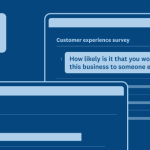Holiday time! A time for overly personal questions.
Holiday time brings with it lots of quality time with family members. And family members bring with them LOTS of questions. So throw on your reindeer sweater and picture this…
You walk into grandma’s house and Aunt Marian pounces on you first, asking loudly, “Are you dating anyone?” Forcing a smile on the outside but cringing on the inside, you excuse yourself, claiming an urgent need for pie. On your way to the pie, Aunt Sue and Aunt Jane manage to corner you and ask the same question, but in low voices. When Aunt Sue sees you hesitate she adds, “Don’t worry, I won’t tell anyone a thing.” Aunt Jane chimes in too, “We’re only curious because we read this article that said that young people nowadays are way too busy to date much. Is that true in your experience?”
At this, somehow, all the details come spilling out–hopefully not within earshot of Aunt Marian. She is SUCH a gossip.
So what does this have to do with surveys?
Surveys are like conversations (see our last blog post for more). That means that some of the same rules apply to surveys. Just like in conversations, when answering surveys, people…
…don’t like to answer personal or sensitive questions. Because people feel uncomfortable or don’t want to give out much personal information, people tend to skip questions on sensitive topics or even drop out of the survey altogether.
…often don’t answer personal or sensitive questions truthfully. You can’t assume that people will be willing to answer every question just because it’s in a survey. In fact, people tend to answer in a way that makes them look like good people, a tendency called social desirability bias. For example, asked if they’ve cheated on a test, respondents tend to say they haven’t, even if they have. It doesn’t even have to be a behavior that’s against societal rules or laws, though. When asked if they’ve voted, people say they have even if they didn’t, in order to look like they’re good citizens.
So what are some solutions?
1. The “AUNT SUE”: Make it clear that the survey is completely anonymous.
It’s best to make it clear that you don’t use any identifying information (like names and addresses) when you analyze the data. That way, respondents will know that their responses can’t be traced back to them, and might be more willing to be truthful.
2. The “AUNT JANE”: Tweak the wording of the question.
There are two main ways to do this:
a. Normalize the behavior. Word the question in a way that makes whatever you’re asking about seem normal or acceptable. If you’re asking about not exercising, you might say, “In talking to people about exercising, we’ve found that people often have too much work to exercise regularly. How often do you exercise?” If the behavior (or lack of one) isn’t seen as embarrassing, the respondent will be more likely to answer honestly.
b. Emphasize that you’re asking for an opinion. Make it clear that you’re asking for a respondent’s personal opinion, not a blanket statement. For instance, if you ask an employee about her supervisor, the employee might feel uncomfortable answering negatively. You can add the stem, “In your opinion…” to the beginning of the question to encourage respondents to tell you how they really feel about the supervisor.
Whatever you do, just remember, no one likes an “Aunt Marian.”
Now you try it!
Have a question you can’t figure out how to ask? Let us know in the comments below.



